Welcome! My first blog post is about a small but significant part of Asian rail transport. An often forgotten destination, which has more than its fair share of interesting trains. From the fast KTX trains, to the cross country Mugunghwa DMU services, it’s an interesting little corner of the world for rail tourists.
The government operator of trains in South Korea is KoRail (http://www.korail.com/en/), and there are decent maps of the KoRail network here and here.
Photography
I didn’t have any trouble taking photos of trains in South Korea. As long as you have a valid ticket (for paid areas) and stay to places where passengers are normally allowed, no-one seems to give a foreigner with a camera a second look. I even came across several Drivers who seemed very happy that I was taking photos of their trains!
KR Pass
KoRail offers rail passes for international visitors, allowing unlimited economy class travel during the period of validity on all KoRail trains (excluding subways/metros). The passes are available for 1, 3, 5, 7 or 10 days consecutive travel and are fantastic value if you plan to make an average of at least 1 journey per day.
To order a pass, you must go to the KoRail website and purchase an exchange voucher (before you arrive in South Korea). You then print the exchange voucher, and take it with your passport to any KoRail station. At the station, they will swap the exchange voucher for a thin, credit card sized pass.
To book seats, go to the ticket counter at any KoRail station (it doesn’t work in ticket machines) and tell them where you want to go. The ticket agent will take your pass, scan it, and hand it back with your ticket.
Planning Your Journey
There are no official KoRail timetables available online, however the KoRail website has a very good journey planner. Go to the booking section and select “Book Online”. Then enter the origin and destination, as well as the approximate time you want to travel. It will give a list of trains available, detailing the train number, time of departure, time of arrival and colour coded indication of train type. Click on the train number for a full timetable of that service.
If the journey planner returns no or very few results try the search again, but select “transfer”. This will give results where there is 1 transfer involved in the journey. You must also be aware that there are two main stations in Seoul; Seoul and Yongsan. Generally, trains on the Busan, Masan and Sinchang lines depart from Seoul, and all other long distance trains (eg Mokpo, Iksan, Yeosu etc…) depart from Yongsan – you must be specific when using the journey planner.
Buying Tickets
The customer service staff at most KoRail stations speak passable English, so booking a ticket usually isn’t a problem. Having said that, it’s best to be sure of the pronunciation of where you are going, or you may find yourself in Daecheon instead of Daejeon! it’s also useful to write down the train number of the service you want to catch (which you can find from the journey planner on the KoRail website). If you’re travelling at a busy time (or any time on the Busan KTX services), have several options ready.
At busy stations, ticket queues can get quite long (I’ve waited over 30 minutes at Busan), so don’t leave your purchase to the last minute. Smaller stations very rarely have a queue.
Boarding trains
At major stations, there are large LED passenger displays, which alternate between Korean and English. These display the vital information of the next dozen or so trains through the station. It shows the train number and type (listings are colour coded by type of train), the origin and destination, the platform number the scheduled departure time and the current variance from timetable (i.e. how late or early it is running). The boards also indicate if the train is at the platform yet with a flashing red dot next to the listing.
When your train is announced (English and Korean), you simply make your way to the platform (no need to show your ticket). At most stations, you are unofficially able to go to the platform at any time, however at some stations the doors are kept locked until they are ready for you. There are signs on the platforms indicating where each car will stop; find the car that corresponds with the one on your ticket and wait there.
When your train arrives, it is best to check the destination on the name plate in the middle of the carriage (older trains) or the LED display next to the door (newer trains) before boarding, just to make sure it’s your train. I had an experience in Dongdaegu late one night, where a late running train was put on the wrong platform. there were no English platform announcements, and had I not checked and discovered that the destination was wrong, I would have ended up in Masan instead of Busan.
On The Train
Staff on Korean trains are impeccably polite. They also bow twice when passing through a car; once on entry, once on exit. It’s an interesting ritual, watch as the staff pass though, and it seems almost seems to be a reflex action
All seats on KoRail trains are reserved, however unreserved standing room is available on some trains. If you have a reserved seat and sit in that seat, you will probably not have your ticket checked during the journey. This is because the conductors have up to date passenger manifests, and know which seats should be occupied. If a ticket has been purchased for that seat, they are not concerned as to who sits there. The only times I saw tickets checked were: when there were people standing, when there was a dispute over whose seat it was (usually due to someone being in the wrong car) or if someone was sitting in a seat they had not been allocated.
Types of KoRail trains:
KoRail ticket prices vary with train type (this is not an issue if you are travelling with a KR Pass). Basically, the faster the train, the more expensive the ticket. There are 5 types of KoRail train:
- Nooriro
- Mugunghwa
- Saemaeul
- KTX
- ITX
Nooriro
Nooriro trains are made by Hitachi in Japan and provide a commuter service between Seoul and Sinchang (a journey of about 90 minutes). They comprise of 4 car EMUs, which have reserved economy seating and standing tickets issued. These are the only non-metro KoRail trains that I saw, which do not have food and drinks for sale.
An interesting feature of the Nooriro trains is their folding steps; when the trains use the high level subway platforms in the Seoul area, the steps remain retracted and the platform is at floor level. When they use the low level long distance platforms, the floor in the doorways lowers and creates steps down from floor level to platform level.
Mugunghwa
You could be forgiven for thinking this sounds like something out of a Harry Potter book; Mugunghwa trains are named after the hibiscus syriacus which is the national flower of South Korea. Mugunghwa trains are the slowest long distance trains and can be sub-categorised as locomotive hauled and DMU. Reserved economy seating and standing room tickets are sold and most trains have some sort of catering car available, selling light snacks and drinks.
Locomotive hauled Mugunghwa trains are led by a variety of locomotives; the most common being the 7300/7400 class diesel-electric locomotives, made in South Korea under licence from EMD (a copy of the EMD GT26CW-2). There are also the 8200 class electric locomotive, based on the Siemens Eurosprinter (model ES64F) and assembled by Hyundai-Rotem and the streamlined 7000 class diesel. These trains are slow and basic, but comfortable, and most have a cafe car, complete with video games and karaoke booths!
Mugunghwa DMUs are manufactured by Hyundai Rotem and run on cross country lines with few passengers. They have a “mini cafe” which comprises of several vending machines located in one of the carriages.
Mugunghwa trains have a red white and blue colour scheme. Locomotive hauled trains vary in number and age of carriages, while DMUs are all 4 cars long.
Saemaul
Saemaul trains are one of my favorite trains ever; they are full of character and look like they belong in an episode of Thunderbirds. They are stainless steel and wear a distinctive blue, yellow and white colour scheme. The normal configuration is in push-pull mode, with a streamlined diesel-hydraulic locomotive at each end of the train. The locomotives are interesting, as they contain a passenger section which forms the first class section of the train. Standing room tickets are not sold for Saemaul trains.
Saemaul trains were once the premier train used throughout South Korea, launched for the 1988 Seoul Olympic games. With the introduction of KTX, they’ve been relegated to a supporting role and as a result, the cafe car is closed on many runs. Saemaul trains have very comfortable wide, velour covered seating. They have a large recline, generous leg room and a large footrest (with thigh support). A long journey on a Saemaul can be very comfortable!
One of the most amusing things I found with Saemaul trains, was the end of the journey. As the train approached its final stop, a muzak version of The Beatles’ “Let It Be” is played over the PA system as a farewell.
ITX
ITX (Intercity Train Express) trains are the newest long distance trains in South Korea. They run between Seoul (Yongsan) and Chuncheon at speeds of up to 180 km/h. They are a mix of single and double deck cars, and a trolley service is available selling snacks and drinks.
I haven’t had a chance to photograph or travel on one of these trains as yet.
KTX
KTX (Korea Train Express) trains are South Korea’s high speed trains, operating at up to 305 km/h. They have a streamlined high speed KTX electric locomotive at each end in push/pull mode. Based on the French TGV, all intermediate cars share a common bogie. Series I KTX trains are 18 cars long (plus 2 locomotives) and series II (KTX Sancheon) are 8 cars long (plus 2 locomotives). Light refreshments are sold from a trolley and first class passengers on series I KTX trains have access to a cinema car.
KTX trains have TV monitors hung from the ceilings, showing local news and human interest stories (all in Korean). They also show the speed and just before each stop, they display the name of the next station. There is also free Wi-Fi available, however with only 1 router shared between 3 cars, the data speed ranges from slow to unusable.
KTX trains run frequent services between Seoul Busan, Masan and Mokpo. During peak times, there is a service every 10 minutes between Seoul and Busan.
Best places to Travel?
South Korea is a very small country (in terms of area); less than half the size of the state of Victoria. Anywhere in the country is accessible within a day, and the KTX network means that all major cities are within 3 hours and 20 minutes of Seoul. Despite this, I have found quite a few interesting trips.
Asan
The quickest is to take a Nooriro train from Seoul to Asan (just under 90 minutes), then a KTX from CheonanAsan (upstairs from Asan) back to Seoul (just over 30 minutes). This gives a good introduction to KoRail trains, without venturing too far.
Busan
A must do journey, is the trip to Busan. A KTX train will do the journey in less than 3 hours, but I recommend breaking the trip up (in one direction, at least). As well as the fast, frequent KTX trains, there are also many local services run by Mugunghwa or Saemaul trains along the route. KTX to Dongdaegu then slow train to Busan will not only give you variety in your trip, but Dongdaegu is a very busy station, with plenty of photo opportunities.
When in Busan, take a local trip to some of the suburban stations (Bujeon, Sasang, Gupo, Hwamyeong or Haeundae). This is a good way to get a trip on a Mugunghwa DMU. Gupo and Haeundae are also quite photogenic little stations.
Mokpo
Mokpo is about as far from Seoul as you can get in mainland South Korea. It’s a beautiful little city, with interesting lane way markets and a sea port. My favorite part of the city is Yudal Mountain. The peak of Mt Yudal is only 228m above sea level, however as the rest of Mokpo is at about 5m, and quite flat, Mt Yudal really stands out. The base of the mountain is about a 20 minute walk from the train station (you can see the mountain from the station entrance – if in doubt, just keep going up), at the base of the mountain is an unexpected find – an orchid exhibition hall.
The climb from the base of the mountain to the peak is not for the faint hearted or the unfit. From the base, you climb 200m vertical in about 400m horizontal distance, much of it is up steps carved into the stone of the mountain. the last few vertical metres see the climber clambering over exposed rocks, with sheer cliffs on either side, but the view from the top is spectacular. In one direction, you can see over the city, with the colourful tiled rooftops of the old town giving way to the new apartment blocks of the suburbs. In the other direction, you can see over the port, harbor and off to the nearby islands.
As with Busan, you can do the trip in about 3 hours 20 minutes by KTX train, however I prefer to mix it up a little. There are slow trains roughly hourly From Seoul (Yongsan) to Iksan via Daecheon. This is a single tracked branch line, that does not host KTX trains which it winds its way through some beautiful scenery and picturesque little towns. At Iksan, you can meet up with a KTX train to take you the rest of the way to Mokpo.
Next Blog Post
My next blog post will be about the subways and Metros of South Korea. Hope to see you then!
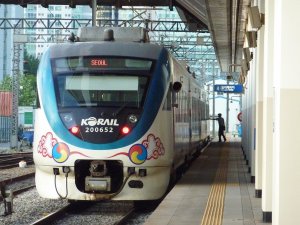
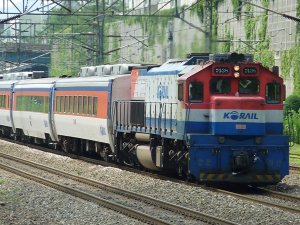
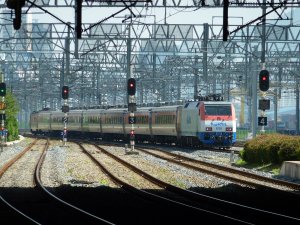
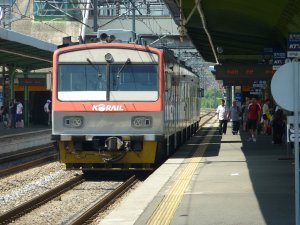
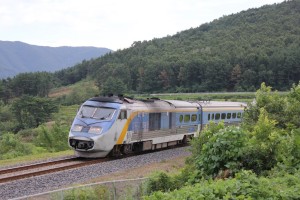
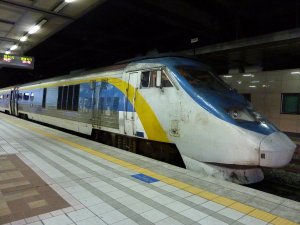
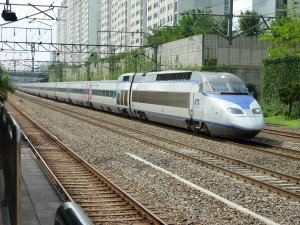
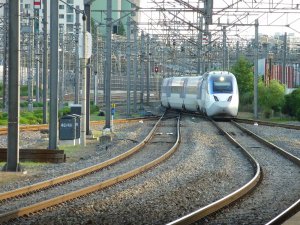
Pingback: Secrets | bluedeckshoe.com·
Hello!
Stumble upon your blog while researching on trains in Korea.
I’ll be going to Korea next month, plan to take the train from Andong to Gangneung, do you think its safe to purchase the train tickets 2 hours before the departure time? Or its better if I buy it the day before? I’ll be there on the 28th of oct, Monday, a weekday, not during festive time. Also, I’ve read about “standing tickets”, what are they called in Korean? I want to avoid buy those tickets.
Last but not least, do you know if there are transfers between Andong to Gangneung? I saw the rail map on KTO’s website (http://visitkorea.or.kr/enu/TR/TR_EN_5_1_2.jsp) that the journey will run on 2 different lines, first on the Jungang Line, then on the Yeongdong Line. Do I need to transfer in Yeongju or it will be a direct train ride?
Thank you! 🙂
Hi there, thanks for writing to me! I’m glad you’ve found my blog helpful.
It’s usually pretty safe to buy KoRail tickets on the day of travel (when it’s not weekend or holidays). I’ve bought tickets a fewof minutes before departure (although I wouldn’t recommend it). The service you’ll be travelling on is a slow, cross country service operated by Mugunghwa trains, which are usually fairly lightly loaded anyway. They do sell standing (unassigned) tickets, but only if the eats are fully booked. They are a little cheaper, but not much.
Don’t worry about a language barrier at the ticket office, most KoRail customer service staff speak reasonable English.
There appear to be 3 direct services daily from Andong to Gangneung (08:02, 12:59 & 18:20) and the journey takes just over 4 hours. If you’re not travelling on a rail pass, the fare should be KRW 13,800 for an adult (around A$14 or US$13.50). Take a look at the ONLINE BOOKING section of the http://www.korail.com/ website for more info.
Hope this helps & enjoy your trip
Thanks for your sharing.
Am i to say that getting a 3/5 days pass is more worth it than individual trips purchase? It is unlimted rides per day I suppose?
My family would like to try out the train trips, but not sure how to go about planning and then back to Seoul. Eg. A day trip journey to Busan , so on the way, maybe i can stop at a station before proceed to Busan. Likewise on the way back. What’s the recommended stations and what to do there?
The rail pass can be much more economical than buying individual tickets. It also allows the flexibility to step on/step off and board any train (if seats are available). It is unlimited journeys and kilometers during the period of validity.
An interesting part of the KoRail network is that the 3 classes of train; KTX/ITX (very fast), Saemaeul (fast) and Mugunghwa (slow) trains have different fares over the same route (eg a KTX from Seoul to Busan will cost considerably more than a Mugunghwa service over the same route). The rail pass allows travel on all train types without having to pay a premium for the fast trains.
If you do want a rail pass, you MUST purchase it before arriving in South Korea. You purchase a voucher for the pass on the KoRail website which is sent electronically. You take a print-out of the voucher, your passport and the credit card used to purchase the pass to the ticket office at any major KoRail station and they will exchange it for the pass (a thin, credit card sized plastic ticket). When you want to buy tickets, you present the pass for the ticket agent to scan at any station.
Busan is a nice day trip. It is even worth staying overnight. Daegu is worth stopping off at on the way (a nice, leafy city). Mokpo is a good day trip from Seoul as well. A beautiful town on the south west coast. For journey planning, you can take a look at the KoRail website. There are no timetables on the site, but if you use the online booking tool, it will show the trains available for that route.
In Seoul, it’s worth remembering that trains on the Busan line depart from Seoul station, but most other long distance trains depart from Yongsan. They are both on subway line 1, two stations away from each other. The airport express subway line (AREX) uses Seoul station.
Hope this helps
Hello, I will be traveling from Seoul to Busan, and back to Seoul again only third day in November. I have some questions, hope you can help.
Will it be more worthwhile if I buy the Pass?
Will I be able to reserve a seat with my Pass, if I exchange my Pass for a ticket at the station?
How many days in advance can I exchange my Pass for a ticket and book seats at the station? Or will I only be able to do it on the day itself!
Thanks!
Hi! A 1 way pass is cheaper than a return KTX ticket from Seoul to Busan (possibly a 3 day pass too – I can’t remember).
IIRC; you can exchange your pass at any major station as soon as you arrive in S Korea. They will ask you what day you want the pass to start. As soon as you have the pass, you can start to book tickets during the period of pass validity.
Tickets can be purchased up to 3 months in advance. As long as it’s not a weekend or holiday, you should be able to buy tickets on the day. During busy times, you should do it as early as possible.
Hope this helps!
Thank you very much for your reply! I will be taking it on a weekday, and will book it 2 days in advance, hope this should be okay? 🙂 -fingers crossed-
Thanks much again for all your help on this matter!
Hi, nice to found this new info! I have several questions regarding the train, is it possible for me to take Saemaul train if I have two luggages with me (one is small one and other is medium size)? Is there any place inside the train to put my lugages? Thanks! 🙂
Hi there. There is plenty of space for luggage on Saemaul trains. There are overhead luggage racks for small to medium items, and luggage space near the doors. Just be careful; most platforms are low level, and require you to walk up 3 or 4 steps onto the train (not so convenient for luggage).
Hello. Thank you for this very useful blog post. I am going to Korea in a few weeks and have been trying to get some correct information about seat reservations on Korail services. I’ve posted the same questions on a couple of forums so I hope you won’t mind if I post them here as well. Any help you could provide would be appreciated.
“Apologies if this sort of question has come up before but I’ve found some conflicting information on the web and would like to get as definitive an answer as possible.
Travelling in Korea from 19-26 April, arriving in Incheon and then going first to Busan (including day trip to Gyeongju) and then back to Seoul. For this, I have purchased a 5-day KR pass.
1) I know that there are frequent KTX trains (every 15-20 minutes) from Seoul to Busan. But I am correct in thinking that I can’t just board any KTX I want – I must reserve a seat? If so, given that I will travel to Busan on a Saturday afternoon, does you think I will have a problem getting a seat, e.g. if I arrive in Seoul station at 2 and want to get a seat on the 2.30 train, do you think there will be any problem?
2) When I go to Gyeongju, I will probably take a Mugunghwa service from Haeundae (where I am staying in Busan) to Gyeongju. This will be on a Monday – surely there is no requirement to reserve a seat on Mugunghwa? Can I just board the train and take my chances with getting a seat?
Hi there! Thanks for reading my blog and I’m happy you’ve found the information useful. I was in the same situation when I first visited S Korea; found very little information on their trains prior to arriving.
The Korail pass is great and very easy to use. When you arrive in Korea, just take the exchange voucher to any major station, and they will give you a credit card sized pass. When you want to book a ticket on a train, you just show them the pass and tell the ticket clerk where you want to go.
To answer your specific questions:
1) You require a seat reservation for any KTX train. The Seoul – Busan trains are often fully booked (all 20 cars), especially on the weekends. If you’re travelling by yourself, you should be ok getting a single seat, but if you turn up to buy a ticket on a Saturday afternoon, be prepared to wait for a few hours, it might be a bit optimistic to turn up at 2pm to buy a ticket for a 2.30 KTX (but then again, you might get lucky). I recommend booking a seat as soon as you are able.
2) Whenever I travelled on the Mugunghwa trains, I made a seat reservation (sometimes only a few minutes in advance), I recommend you get a seat allocation from the ticket office when you arrive at the station (Haeundae is staffed). There was only 1 Mugunghwa train I travelled on that had all seats occupied, but people kept boarding – when all seats are taken on Mugunghwa and Nooriro trains, standees are allowed.
Hope this helps!
Thanks very much for your reply – very informative. Just to clarify, if I want/need to (i.e. if I have no time), I can just board a Mugunghwa with my Rail Pass but without a seat allocation?
For the KTX to Busan, I will try to reserve seats when I arrive in Incheon AIrport
I never tried that myself, but I don’t think you would have too much trouble. Worst case scenario, you would have to stand. This is very unlikely, especially for a mid-week train departing from Haeundae. But, as I said, I never tried it myself.
The KoRail staff I have encountered have all been extremely polite, and treat pass holders with extra reverence.
I will be travelling from Seoul to Busan on May 11 to May 13, this means that I can get the 3 days KR pass which costs me 83,700 won instead of getting 2 one way tickets at 57300 won right?
Yep, that’s right! It almost seems too good to be true that a 3 day pass is less than a return fare! It’s the same in Japan too – this seems to be the main reason that it isn’t open to permenant residents (only tourists.)
The only issue is that you can’t book the tickets until you have exchanged the voucher for the pass (after arriving in S Korea). Trains run every 5-20 minutes on this line, so as long as you’re a bit flexible as to what time you travel, there shouldn’t be a problem.
Just don’t forget that you need to purchase the exchange voucher before you leave your home country.
Just some feedback from my rail experience in Korea. Getting the rail pass exchanged in Incheon Airport was very straightforward (NB – the rail pass can’t be used on the trains to and from the airport). Arrived in Seoul Station at about 1pm, proceeded to the tickets counter and got seats on the 2.15 train to Busan. I probably could have got a seat on an earlier train if I had wanted.
The train itself was full so it shows the value of getting the ticket as soon as possible, it was a Saturday as well. The train is fine – comfortable and fast but perhaps lacks the wow factor you get from travelling on shinkansen in Japan.
In Busan station, I was also able to reserve seats on a mugunghwa service from Haeundae to Gyeongju. It’s a good idea to also reserve seats on a mugunghwa service as the seats seem to fill up quickly, even on a Monday morning trip. We were accompanied by a large group of retired persons on a walking trip so it was nice and lively.
Thanks again to theraillife for advice and tips
Hi! I have the same case with the OP — I’m going to Seoul on May 17-27 and plan to travel to Busan from May 19-21 and staying at Haeundae until morning of the 21st. On 21st I’m planning to go to Gyeongju from Haeundae and then travel back to Seoul from Gyeongju.
Given this type of itinerary, would you recommend getting the 3-day KORAIL Pass? Is the Pass valid for a train trip from Haeundae Station to Gyeongju or do I need to buy separately for that?
Thanks in advance for all the help! 😀
I’d always recommend the rail pass, as long as you’re planning an average of at least 1 journey per day. The pass is valid for whole days of travel, not point to point. For example, a 3 day pass is valid from 0:01 on the 1st day to 23:59 on the 3rd day. This allows for unlimited trips in economy class on any train (except subways) during that time.
You can also exchange your voucher for the pass in advance. For example, if you want to start using the pass on Thursday, you could exchange the voucher for the pass on Tuesday, then immediately book a train for any time during the period of validity.
Hope this answers the question!
Hi!
I stumbled across your blog while looking for details on KORAIL Pass, and I hope it’s okay if I ask for some advice!
I’m travelling to Seoul and planning to have a 3-day visit out of Seoul in the middle of my travel days, and my plan is to go from Seoul to Busan, stay in Haeundae for 2 days then travel to Gyeongju on the third day before travelling back to Seoul. I’m planning to buy a 3-Day KORAIL Pass but the current cost of the 3-Day pass seems like it isn’t that far off from just buying individual tickets for each travel..
Can you advise me what might be the best course of action please? Thank you!
Hi! I’d always go for the rail pass, it gives you more flexibility. You can break your journey at no extra cost, also you can take any type of train. There are 3 different fares over any route depending on the type of service; Mugunghwa is cheapest, then Saemaeul with KTX/ITX most expensive. The rail pass allows you to travel on any service (with no surcharge).
Another benefit of the railpass is that if you miss a train, they will rebook you on the next train for free (even after the train you were already ticketed on has departed). This happened to me twice; what could have been a disaster turned into a minor hiccup.
Only negative about the rail pass is that you can’t use the Internet booking system (have to buy tickets at stations after the pass is issued)
Thank you so much! That gives me much relief. I was thinking any incremental difference in cost of buying the Pass would be outweighed by the advantages of having one, especially for a foreigner travelling outside Seoul for the first time with just basic knowledge of the Korean language like me! But I needed reassurance and I trust your advice after I read this blog post, so thanks again 😀
I’ll go ahead and order the Pass now for my trip to Seoul next week! 😉
I was not knowing about Rail pass, I have already in South Korea , can I now able to get 10 Days pass to explore this flexible travel pass to explore it?
Hi there. As stated in my blog (and also a couple of times in my replies), the pass MUST be purchased BEFORE you arrive in South Korea. You cannot buy the pass after arriving in the country.
Hello I was wondering if you could help me? I have a 10day KorailPass, I am traveling Seoul to Ulsan and want to upgrade to 1st class, is the 50% discount a straight discount off the full fare or a 50% discount off the difference? Do you know roughly how much it is? Thanks.
Hi there. Not sure about 1st class upgrades, never bothered with it myself. I presume that you would just pay the 1st class fare premium (ie the difference between 1st and 2nd class fare). To work this out, do a mock ticket booking on the website and subtract the 2nd class fare from the 1st class fare.
Hi there. Do you know whether all major train stations along the KTX lines have luggage storage services, for example Suwon Station? Is there a cost and how much would that be for a luggage that is approximately medium sized? Thanks 🙂
Hi Millie
I didn’t pay that much attention, but I do recall coin operated luggage lockers at major stations such as Seoul, Dongdaegu and Busan. I don’t recall the exact fee, but they were under 10,000 WON per use.
Pingback: 10 essential tips for European train travelBig Online News | Big Online News·
Hi, thanks for your blog.
I need your advise. We are a big group of 11 people, arriving on dec Sunday morning at incheon about 7am.
We would like to travel to Busan (for 2 nights) — Seoul ( in between going Nami Island, Mt Seorak , everland, MBC drama village and shopping belts ) — ski resort — seoul — incheon airport
1. Based on the above should I get a travel pass for 11 days ( but I will not need it at the ski resort which takes up 5 days.
2. How do I pre book the seats to Busan ? On Sunday morning, would it be difficult to ensure everyone has a seat
3. Should we extend a day in Busan to visit Gyeongju ?
4. Should we travel by express bus to Nami instead of using train ?
5. At Busan, is there any tourist train like V train or S train ?
6. How do I get discount for tickets ? Some website indicate that tourist can get discount for their KTX tickets, so should I buy online or at the counter ?
7. Should I get return tickets for incheon — seoul — busan — seoul — incheon ? Or break up the tickets by trips
Hi there, sounds like a great holiday you have planned! I only have experience on solo travel, but I’ll help as much as I can.
1. You might be better off getting 2 separate passes; 1 before your ski trip and 1 after.
2. If you are travelling on a rail pass, you can’t book the seats until you pick up the pass. If you just want to buy tickets, you can do it up to a month in advance over the website http://www.letskorail.com/ebizbf/EbizBfTicketSearch.do .
Weekends can be busy, but there are plenty of trains. I’m not sure how successful you’d be trying to get 11 seats together on a KTX at short notice. The slower trains are less busy if you’re not in a hurry.
3. Depends on how much you want to see it! Busan is a nice place and worth visiting, but you could say that about most cities and towns in S Korea.
4. I would always choose train, but it depends on what suits your needs. I’m not familiar with Nami, is there a station close by?
5. Not sure what you mean by V or S train. Bus an has a subway system (see http://urbanrail.net/as/kr/busan/busan.htm). Also, regional KoRail trains provide service to nearby towns and outer suburbs.
6. The only way I’m aware of tourists getting a discount for tickets is buy purchasing a rail pass prior to entering S Korea. In that case, you need to present your rail pass at a ticket counter for tickets
7. It’s best to buy your tickets as soon as you know your travel dates. You can always change them later if required.
Hope that helps!
Thank you for your speedy reply. Btw, the vtrain and strain are the tourist train and it’s really fun to be on it. I had tried it last year.
Hi there
Thank u for the blog. I would like to get an advice as I will be visiting Korea in a group of four in early December. We will arrive in Busan and will take a train to Seoul. From there we’ll visit sokcho and pyeongchang, nami island etc.
1) Is it more worth if I buy the group saver korail pass or not?
2) Do we use any other train line apart from KTX and subways to those places?
Hope u can help, thank u
Hi there, sorry it took so long to get back to you! I’ve been on holiday.
1) The group saver is good (cheap), as long as you al travel together.
2) Busan – Seoul is KTX, Seoul – Nami Island (Chuncheon) is eithr subway or ITX. I’m not aware of any train that goes to Pyeongchang or Sokcho.
Hi there,
I’m planning to have a trip from Busan to Seoul on 8th Nov, and after checking price for train ticket and the KR Pass and i found the single journey train ticket are cheaper compare to KR Pass. Thus, is it correct to get the normal ticket if i want a single journet?
That’s right. It’s cheaper to buy a single ticket if you’re only making one journey.
Hi there. Finding your blog is very useful.
I’m gonna have my 3rd trip to Korea again in coming Nov.
I wanna take Nooriro from Suwon to Seoul. Where is the station will be ended up in Seoul?
Btw, how do you obtain the info of station served for each of those five speedy train? Is there any website?
Many thx,
Elny
Hi there. The Nooriro trains make stops at several stations in inner Seoul (including Yongsan), before terminating at Seoul.
KoRail have a good search feature on their website at http://www.letskorail.com/ebizbf/EbizBfTicketSearch.do – you can search by destination and train type.
Hope this helps!
Hi,
Stumbled upon your blog while searching information regarding KTX rail pass. I am bit confused on the saver pass, hope you can help. We will be travelling in a group of 3pax from Seoul to Busan and I am planning to get the saver pass for 1 day & will be staying in Busan overnight. Does the rate stated on the website is the total amount we need to pay? (ie: 3pax=60300won)
Thanks!
Amj
Hi there Amj. The price on te website is per person, so if you’re travelling in a group of 3, you’re entitled to the saver rate of KRW 60,300 (per person). For your group, this would be 3×60,300 (KRW 180,900).
A one way KTX ticket is KRW 53,300 per person. So if you’re only doing one journey, it may be cheaper just to buy the tickets. If you’re planning on doing other regional or inter-city trips, the pass would be more economical.
Hope this helps!
Hi there, I happened to stumble across your blog while researching on travelling by train to busan. My friends and I ( 5 of us ) intend to travel for a 2D1N trip to busan, and I was wondering if getting a KR pass (3 days ) or individual tickets would be better.
And in the event we get the KR Pass, are we able to book the train tickets to and from busan? Eg we arrive at the airport, collect our pass and book both train tickets on the spot, as the day we’re leaving busan happens to be the day we’re flying back to our home country from Incheon airport, so I’m just afraid we wont be able to get on an earlier train.
Thank you! 🙂
Hi there. If you’re only doing 1 long distance journey, it’s probably cheaper to get single tickets.
You can book tickets months in advance (3 months?). If you buy single tickets, you should be able to do it over the internet. If you’re using a pass, you can book your tickets when you pick it up. Any staffed station can book tickets from and to any station, so you can buy tickets from Busan to Seoul in Seoul (at Seoul or Yongsan). Be careful; sometimes the lines for tickets are very long.
Hope this helps!
Hello.
Thank you for your information. I plan to use Korail Pass for 5 days on weekdays next month. I would like to ask,
1. Can I just buy it cash at Seoul Station on the day I arrive (I’ll use it 4 days after I arrive)?
2. As I will be using my father’s credit card to book (which he doesn’t follow the trip), can I bring the photocopied version?
Thank you.
Rabeah
I was planning to go to Suwon (wanna visit the fortresss) early morning and take the train from Seoul. Is it advisable? My flight departs on the same day at 10:30pm.
The trains are generally very reliable (particularly KTX & ITX). They are also the fastest and most comfortable way from A to B. Make sure you book your return ticket before you leave, and keep plenty of time before your flight, but otherwise, you should be fine!
Hi!
This page is helpful. Though I want to ask if I really need to book in advance for ITX or can I go and buy the ticket on the same day?
A friend and I plan to use ITX from Yongsan station to Gapyeong station.
Hi There
Glad you found the page useful. You can get tickets for any type of train (except KTX or Saemaeul) at any time up until departure time, as they sell standing tickets after all seats are full. The earlier you book, the better your chances of getting a seat. There are no standing tickets on KTX or Saemaeul trains.
Loved the information on your post! I have a trip coming up in September and just want some information on what you think I can do. I will be staying in Seoul for a week but want to do outside traveling and go to Busan. If I purchased a KR Pass can I also use the local trains in Seoul for that as well? Or is the KR Pass only good for long distance travelling like going to Busan? I’m trying to figure out if it is worth it to purchase the pass or not.
Hi there, glad you found the post useful! A KR Pass can’t be used on any subway services, but it can be used on local KoRail services. For example, the Line 1 Subway in Seoul goes through Cheonan station. You can’t use your pass on this line, but you can use the KTX services to the adjacent Cheonan-Asan station. There are similar suburban stations in Busan, which are right next to subway stations.
Hi! I’m planning my travel to Korea and googled your blog. You had a lot of incredible railway travel experience! That’s wonderful!
In fact, Korail has its official train timetable updated over its website. You can check this link: http://www.letskorail.com/ebizcom/cs/guide/guide/guide11.do
Thanks! Glad to hear that my blog was useful. There’s not much info on their wonderful train network.
Thanks for the link to the timetable, too!
Hello! Thank you for the useful information on ur blog!
I’ll be visiting Korea in December and would just like
some advice. I will be staying near Hoehyun station and
i was planning to go from there to Yongsan station to take
ITX to Gapyeong Station before taking the shuttle bus
to Nami Island. The next day I’m planning a one day trip
to Busan, and the third day I’m thinking of taking a tourist
train (O/V train).
Was wondering if it sounds feasible to take the 3 day pass
(my brother & i are youths, and i have 3 other fam members
planning to take the group saver pass)?
Also, this pass works for the ITX that I mentioned above right? 🙂
Thank you in advance!
Hi thanks for sharing all this information
I am planning my trip to korea next year for 12 days and needed some advice i am planning to travel from seoul to busan (2 days ) and daegu (2days) than back to seoul and visiting nami island too i am trying to figure out how to plan it and which pass to buy is more worth it.
Great article, does the Saemaul trains have a food cart or services? Cheers!
I was also wondering, I like the idea of taking a long train trip if there’s a bit to see, or would it be recommend to just take the bullet train as that’s enough time on the train through the country or is the Saemaul fun as well?
The KTX trains show you plenty and get you there fast, although they run through many tunnels (especially on the northern end of the Busan line). The regional trains are fun if you have time.
Hi, sorry for the delay in responding. There are not so many Saemaul trains any more, as most have been replaced by ITX. ITX don’t have food carts, the remaining Saemaul may or may not have a cafe car.
Very helpful blog, especially about Korea. Thank you very much!